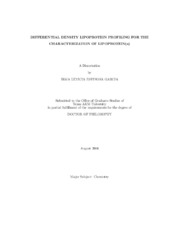| dc.contributor.advisor | Macfarlane, Ronald D. | |
| dc.creator | Espinosa Garcia, Irma Leticia | |
| dc.date.accessioned | 2006-10-30T23:31:00Z | |
| dc.date.available | 2006-10-30T23:31:00Z | |
| dc.date.created | 2006-08 | |
| dc.date.issued | 2006-10-30 | |
| dc.identifier.uri | https://hdl.handle.net/1969.1/4359 | |
| dc.description.abstract | Lipoprotein(a) (Lp(a)) has been described as an emerging risk factor for cardiovascular
disease. The complexity of the Lp(a) molecule sets a challenge for the determination
of the risk it represents for the cardiovascular system. The objective of the
present study was to develop a rapid method for the separation, purification, density
measurement, and characterization of Lp(a) from serum using a procedure that is
isoform independent.
The objective was met by linking ultracentrifugation with affinity separations for
the specific separation of Lp(a) from other lipoproteins. The mean density distribution
of Lp(a) was determined by a differential density lipoprotein profile (DDLP).
For DDLP, the lipoprotein density distribution of a serum sample with elevated Lp(a)
levels was determined by ultracentrifugation using NaBiEDTA complex as a density
gradient. Lp(a) was removed from a second aliquot of the same serum sample by
carbohydrate affinity using wheat germ agglutinin (WGA). WGA was demonstrated
to have high specificity for Lp(a) in serum. The Lp(a)-depleted sample was ultracentrifuged
to obtain a lipoprotein density distribution in the absence of Lp(a). A
DDLP was obtained after subtracting the Lp(a)-depleted lipoprotein density profile
from the untreated lipoprotein density profile. DDLP gives relevant information of
the lipoproteins in serum such as density, Lp(a) isoform, and subclass characteristics.
Lp(a) was quantitatively removed from serum with a recovery efficiency of more than 80%. Lp(a) was purified by ultracentrifugation. Lp(a) obtained in this way
retained its inherent density and immunoreactivity. Lp(a) was further characterized
by gel electrophoresis and Western blot as well as by capillary electrophoresis.
Capillary electrophoresis demonstrated to be a powerful analytical technique for the
characterization of Lp(a) and apoprotein(a) isoforms.
The major outcome of this research was the effectiveness of using affinity separations
coupled with density ultracentrifugation for the isolation of pure Lp(a) from
serum and its isoform characterization based on density and electromobility. The
methodology developed and described here are relevant in a clinical setting for the
analysis of Lp(a). | en |
| dc.format.extent | 14741438 bytes | en |
| dc.format.medium | electronic | en |
| dc.format.mimetype | application/pdf | |
| dc.language.iso | en_US | |
| dc.publisher | Texas A&M University | |
| dc.subject | Lipoprotein(a) | en |
| dc.subject | Density | en |
| dc.subject | DDLP | en |
| dc.title | Differential density lipoprotein profiling for the characterization of Lipoprotein(a) | en |
| dc.type | Book | en |
| dc.type | Thesis | en |
| thesis.degree.department | Chemistry | en |
| thesis.degree.discipline | Chemistry | en |
| thesis.degree.grantor | Texas A&M University | en |
| thesis.degree.name | Doctor of Philosophy | en |
| thesis.degree.level | Doctoral | en |
| dc.contributor.committeeMember | Russell, David H. | |
| dc.contributor.committeeMember | Schroeder, Friedhelm | |
| dc.contributor.committeeMember | Williamson, Vickie M. | |
| dc.type.genre | Electronic Dissertation | en |
| dc.type.material | text | en |
| dc.format.digitalOrigin | born digital | en |


